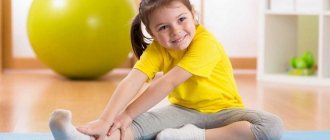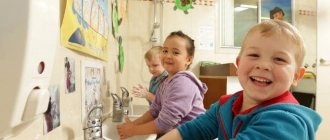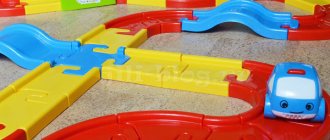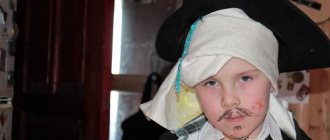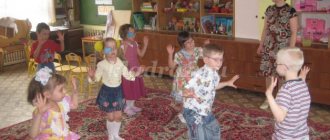Summary of preparation for breakfast and breakfast in the senior group
Nina Konstantinova
Summary of preparation for breakfast and breakfast in the senior group
Program content:
Educational objectives:
-Form the habit of a healthy lifestyle; culture of behavior while eating: use cutlery correctly; ability to use a napkin carefully; do not crumble bread, chew food with your mouth closed, do not talk while eating.
Developmental tasks:
-Develop fine motor skills, the ability to properly use a paper napkin.
Educational tasks:
-To instill in children politeness, the need for cleanliness and neatness.
Previous work: prepared napkins for setting the table, word game, saying “When I eat, I am deaf and dumb”
.
Preparation of material : aprons for duty officers.
Preparing and holding breakfast
After morning exercises , children change their shoes, go to the group and engage in independent activities. The junior teacher leaves for breakfast . At this time I appoint people on duty.
-Diana and Dima will be on duty today. Diana and Dima go to wash their hands and put on aprons, after which they will begin to lay out napkins and lay out spoons. While the attendants are setting the table, I invite the other children to go to the washroom, but first, let’s remember the rules for washing hands. Children, let's answer one by one.
-First you need to roll up the sleeves; then open the tap not too much so as not to splash water; wet your hands; take soap; lather your hands in a circular motion; put soap; wash your hands with soapy foam; Gently rinse off the soap with water; shake your hands off the water; Close the tap; go to your towel, take it off the hanger; dry your hands - apply a towel tightly, wipe your palms and fingers, first on one hand, then on the other hand; hang the towel back.
-Boys wash their hands first, and girls check . Then the girls wash and the boys check .
Good water!
Help a little:
You, a piece of soap, wash us without sparing,
Our hands will become cleaner and whiter.
-That's how great you are. Did everyone wash their hands well?
-Guys, sit down quietly in your seats. The chefs took care of you, prepared this very healthy and very tasty rice porridge, cocoa and butter sandwich. To make them happy, let’s do something nice for them, let’s eat all the porridge! Bon Appetit everyone!
-Children, do not forget that we hold the spoon in our right hand and the bread in our left. We hold our back correctly, our legs stand correctly, we don’t put our elbows on the table, we chew food with our mouth closed, we don’t talk while eating, we don’t crumble bread on the table. I praise the children for their neatness, slowness, and cultural skills. I remind the children to say thank you for the food.
-The attendants do not forget to clear the table: napkins, spoons, plates, slowly, holding them with both hands.
Analysis:
Well done! Everyone finished the rice porridge, ate it very carefully, and took their time.
Organization of regime moments in preschool educational institutions.
Author: Voronina Elena Alekseevna
Educational institution: MBDOU "Child Development Center - Kindergarten No. 7"
Location: Kalach, Voronezh region
Topic: Organization of regime moments in preschool educational institutions.
Library section: Articles
Publication date: 13.04.2019
When bringing their children to kindergarten, the first thing parents hear is the words “regime”, “routine”. For some, especially inexperienced, fathers and mothers, these words are alarming and alarming. “Will life according to the schedule be too difficult for the child?”, “Will the child be able to join the team, will he get used to living according to the schedule?” - educators often hear such questions from parents. After all, family life is rarely built according to strict time rules, and children get used to a free schedule of life activities: when the child wanted to eat, they fed him, he wanted to sleep, he put him to bed. Games and walks in the family are also organized spontaneously, according to the mood or when the parents have free time.
The routine in kindergarten is the basis for organizing children’s lives, a flexible and dynamic design, but at the same time its main components (daytime sleep, wakefulness, intervals between meals, night sleep, total walking time) must remain unchanged.
Requirements for the regime are determined by the psychophysiological characteristics of the child’s age, educational goals, and environmental conditions. The regime should take into account the age characteristics of children, be constant (although there are differences in the construction of the daily routine at different times of the year), take into account the time the child spends in kindergarten, and the parents’ working hours.
The regime is usually understood as a scientifically based routine of life, providing for a rational distribution in time and sequence of various types of activities and rest.
In a child accustomed to a routine, the need for food, sleep, and rest occurs at certain intervals and is accompanied by rhythmic changes in the activity of all internal organs. The body, as it were, adjusts in advance to the upcoming work, so it does not cause fatigue.
When carrying out routine moments, the following rules should be adhered to: complete and timely satisfaction of all organic needs of children (sleep, nutrition); careful hygienic care; ensuring cleanliness of the body, clothes, bed; attracting children to participate as much as possible in regime processes; encouraging independence and activity; formation of cultural and hygienic skills; emotional communication during routine processes; taking into account the needs of children, the individual characteristics of each child; a calm and friendly tone of address, careful attitude towards the child, elimination of long expectations, since the appetite and sleep of children directly depend on the state of their nervous system. Regular moments include: reception of children, examination, games, morning exercises; breakfast preparation, breakfast, games and children's activities; direct educational activities; preparation for a walk, walk; returning from a walk, preparing for lunch and lunch; preparation for bed, naps; getting up after sleep, water procedures, hardening activities; games, independent activities of children; preparation for dinner, dinner; games, walks, children going home.
Morning reception.
Of great importance in organizing the whole day is the morning reception of children, held in the warm period of time in the air. Each teacher has the opportunity to keep all children occupied and interested, communicate with parents, and determine the condition and mood of the students. Reception of children by a teacher can be carried out in a group or on site, which must be indicated in advance when planning work. The most important thing is to create a good mood for both the child and his parents. Before receiving children, the teacher ventilates the group. During the morning reception, it is necessary to pay attention to the appearance of the children.
Children who come should greet the teacher and other children in the group, join in the games, talk quietly, and not shout. The teacher provides interesting, meaningful activities for children and makes sure that they do not quarrel or interfere with each other. If a child is shy, self-conscious, not in the mood, or for some other reason cannot independently choose an activity, the teacher should help him: connect him to playing children, help in choosing toys, play with the child, or give him some specific activity. order. The teacher also provides conditions for varied and interesting independent activities of children in a group or in the area. To do this, he systematically introduces new (or already forgotten) aids that will contribute to the emergence of playful or creative ideas in children.
Educational activities in children's independent activities.
According to the Federal state requirements for the structure of the basic general education program of preschool education, educational activities are carried out in the process of independent children's activities. This requires the creation of special conditions:
organizing a subject-based developmental environment that stimulates children’s expression of independence and creativity, and the development of children’s interests; the teacher’s use of special methods and techniques that encourage children to demonstrate independence and creativity in various types of activities, individual interests and inclinations. Forms of independent activity of a child in kindergarten:
educational and logic games; musical games and improvisations; independent activity in the book corner; independent visual activities of children's choice; To organize the child’s independent activities in the group, various “sports centers”, etc. are created.
Educational activities carried out in the morning:
observations: in a corner of nature, of the activities of adults (table setting for breakfast); individual games and games with small subgroups of children (didactic, developmental, plot, musical, active, etc.); creation of practical, playful, problem situations and situations of communication, cooperation, humane manifestations, manifestations of emotional responsiveness to adults and peers; work assignments (caring for indoor plants, etc.); conversations and discussions with children based on their interests; viewing didactic pictures, illustrations, watching video materials of various contents. In the morning, the teacher conducts gymnastics with the children. At the same time, the teacher works together with the children and, if necessary, corrects and corrects the children’s exercises.
Preparing for breakfast, breakfast.
Rational organization of nutrition in kindergarten primarily depends on strict adherence to the regime. Breakfast, lunch, and afternoon tea should be served at the same time every day, without delay, since long waits can reduce children's appetite. Half an hour before meals, stop noisy and active games; it is better to read a book to the children, or play board games.
The children are always introduced to the menu and told what will be served: this broadens their horizons, enriches their vocabulary and, of course, whets their appetite. An important educational moment is eating, in order to develop cognitive activity and curiosity; before breakfast, it is advisable to organize educational games such as “What did the cook prepare?”, “Edible - inedible”, “How useful?”, “Guess what? ", didactic games and conversations about the health benefits of foods and the variety of dishes. A favorable period for individual work is table setting: you can offer the child a logical puzzle, a problematic situation, create an incorrect table setting and ask him to think about whether everything has been done correctly. If work with children is done at the proper level, then even children of the first junior group can tell a guest who drops by during breakfast that they “ate salad with onions so as not to get sick.”
Hygiene procedures.
The implementation of these routine moments in different groups also has some differences. The purpose of hygiene procedures in younger groups is to teach children self-care skills, and at an older age, the acquired skills are consolidated and form the ability to perform them independently, without reminders, based on ideas about their necessity and benefits.
Methods for developing cultural and hygienic skills differ for different ages. Most appropriate in groups of early and primary preschool age:
display; explanation; direct guidance of actions (the teacher rolls up the children’s sleeves; soaps their hands; holding the child’s palms in his hands, makes circular movements with them, developing a motor skill); use of artistic words, folklore; game techniques (a doll or another character comes to the children, to whom they show how to wash themselves, dress for a walk, fold clothes). Older schoolchildren no longer need to be shown all the stages of washing and dressing; a question, a reminder, encouragement, and praise are enough for them. To consolidate knowledge about the benefits of hygiene procedures, children of older groups can be shown a fragment of the cartoon “Moidodyr” or use slides, a multimedia presentation about hygiene products, items of clothing, depending on the technical equipment of the group.
Reception and praise are relevant in all age groups, but comparison with other children is undesirable. It is permissible to compare only the achievements of the child himself, past and present, emphasizing progress: “Yesterday you didn’t succeed, but today you rolled up your sleeves, washed your hands clean, carefully turned and folded your clothes, well done!”
Older preschoolers should not only be able to undress independently for bed and dress for a walk, eat with a spoon, fork, and use a knife. They also put their clothes in order on their own, tie shoelaces, fasten buttons, take care of their appearance and eliminate clutter: comb their hair, straighten their collar, tuck a shirt, T-shirt into tights or trousers. In the junior and middle groups, most of the procedures for caring for the pupils’ appearance are carried out by the teacher and his assistant, gradually accustoming the children to these actions.
Direct educational activities.
When planning direct educational activities with children, educators organize classes with preschoolers in accordance with the schedule of classes in a given age group. When preparing, it is necessary to determine the main purpose of the lesson: will it be developmental in nature or pursue a purely educational goal. In the educational lesson, children accumulate the necessary personal experience - knowledge, abilities, skills and habits of cognitive activity, and in the developmental lesson, using the acquired experience, they independently acquire knowledge.
When writing a GCD summary, focus on the following sequence: topic of the lesson; type of occupation; age group; the date of the; purpose of the lesson; tasks (educational, educational, developmental); methods and teaching techniques used in the lesson; materials and equipment; organizing children for classes; preliminary work; lesson plan; progress of the lesson.
Preparing for a walk, walk. A walk during the daily routine of a preschool institution is extremely important, and its benefits for children are undeniable for the following reasons:
Staying in the fresh air saturates the body with oxygen, strengthens and hardens thanks to natural factors (temperature difference compared to the room, wind, etc.). Children have the opportunity to move freely in a spacious area, run, and perform physical exercises that are not always appropriate in a group (ball games, riding bicycles, scooters). Children who like to make noise do not need to restrain themselves, because while walking you are allowed to shout and play noisy games, which is not welcome indoors. During the walk, naughty girls who had to restrain themselves get emotional relief. In addition to physical development, walking also brings cognitive benefits. After all, during them, children have the opportunity to observe natural phenomena, animals, plants, the work of adults, transport, houses, passers-by, and also engage in research activities. Before going for a walk, it is necessary to restore order in the group: collect toys and place them in their places, remove manuals and materials that were used in direct educational activities.
Before getting dressed, the teacher reminds children of the rules of conduct in the dressing room. In this regime moment, the teacher develops in children the skills of dressing and the culture of behavior when dressing, solves a wide range of educational tasks: the name of clothing and its purpose, the name of the details of clothing and the activation of the dictionary on the topic “Clothing”. The teacher draws the children’s attention to the sequence of dressing, and before going out for a walk, to the children’s appearance. If during the process of dressing someone makes obvious mistakes, the teacher eliminates them together with other children in the group, while making the children want to help each other and stopping ridicule from their peers.
Organization of a walk.
During the walk, the teacher helps children organize interesting and varied activities. To do this, there must be toys and auxiliary equipment, the rules for handling which the teacher teaches children during a walk or previously in a group. During the walk, the teacher has the opportunity to observe the content of the games and the children’s relationships and adjust them if necessary.
The daily duration of children's walks in preschool educational institutions is about 4-4.5 hours. The walk is organized 2 times a day: in the first half of the day before lunch and in the second half of the day after a nap and (or) before the children go home. When the air temperature is below -15°C and the wind speed is more than 7 m/s, the duration of the walk is reduced. The walk is not carried out at an air temperature below - 15°C and a wind speed of more than 15 m/s for children under 4 years old, and for children 5-7 years old - at an air temperature below - 20°C and a wind speed of more than 15 m/s.
Walk structure:
observation; outdoor games; individual work with children; work; creating conditions for children’s independent activities.
Before leaving the walk, the children tidy up the area and collect the materials they take away. Before entering the kindergarten, the children wipe their feet and learn to enter calmly, without jostling, arguing, or interfering with each other. In the locker room, the teacher monitors the process of changing clothes and instills in children
careful handling of things and neatness skills.
Preparing for bed, napping. After lunch, under no circumstances should you immediately put your children to bed. After eating, at least 15 minutes should pass. It is better that the period of preparation for bed be calm and balanced. Children are not recommended to be distracted by noisy games or emotional conversations. When undressing, the teacher develops a caring attitude towards things and neatness. The bedroom environment should be calm and relaxing. A gentle lullaby, folk nursery rhymes and sayings will help create the right mood and a positive attitude towards daytime sleep. It is necessary to check whether the children are comfortable in their beds, or even better, approach each one, straighten the blanket, pat them on the head and wish them a restful sleep. This way you will show your child your love and care, and create a peaceful mood that promotes good sleep.
Awakening gymnastics.
Gymnastics after daytime sleep in combination with contrasting air baths helps to improve mood, muscle tone, and also ensures the prevention of postural disorders and flat feet. A set of gymnastics after a nap should not duplicate morning exercises. The selection of the content of this gymnastics is based on taking into account the children’s motor experience and the thematic content of the educational process. The duration of the gymnastics is 7-15 minutes. When organizing awakening gymnastics in kindergarten, you must follow the principle of gradually raising children to the sounds of music that evokes positive emotions.
Scheme for performing health-improving exercises after a nap:
gymnastics in bed; exercises aimed at preventing flat feet and postural disorders; breathing exercises; individual or differentiated health work; water procedures.
Awakening gymnastics helps the child’s body wake up, improves mood, and improves muscle tone. It is aimed at the gradual transition of children from sleep to wakefulness. The main rule is to avoid sudden movements that can cause muscle strain, overexcitation and, as a result, dizziness.
During its implementation, musical accompaniment is advisable. Music has a positive effect on children's emotions, creates a good mood in them, instills cheerfulness and joy, helps the rhythm of movements, and makes them easier to perform.
Educational activities carried out in the afternoon:
Joint play between the teacher and children is aimed at enriching the content of creative games, and children mastering gaming skills necessary for further organization of independent play. Situations of communication and accumulation of positive socio-emotional experience are problematic in nature and contain a life problem that is close to preschool children, in the resolution of which they are directly involved. Such situations can be of a real-practical nature, of a conditionally-verbal nature (based on life plots or plots of literary works) and imitative-game ones. In situations of a conditionally verbal nature, the teacher enriches children’s ideas about the experience of solving certain problems. In real-life practical situations, children gain experience in showing a caring, sympathetic attitude towards people, and take part in important matters (“We plant seedlings for flowers”, “We decorate the kindergarten for the holiday”, etc.). Situations can be planned by the teacher in advance, or they can arise in response to events that occur in the group and help resolve emerging problems. Sensory and intellectual training is a system of tasks, mainly of a playful nature, ensuring the formation of a system of sensory standards (color, shape, spatial relationships, etc.), methods of intellectual activity (the ability to compare, classify, systematize according to any attribute, etc.). This includes educational games, logic exercises, and entertaining tasks. Children's leisure is a type of activity purposefully organized by adults for play, entertainment, and relaxation. As a rule, the kindergarten organizes leisure activities such as “Health and outdoor games,” musical and literary leisure activities. In this case, leisure time is organized as a “circle”, for example, for doing handicrafts or artistic work. Collective and individual labor activity is of a socially useful nature and is organized as household work and work in nature. Educational activities at scheduled times in the afternoon are organized with small subgroups of children or with the group as a whole. In parallel, children are given the opportunity to organize independent activities based on their interests. The atmosphere of freedom of choice, creative exchange and self-expression is created by the teacher. In subgroups, the method of joint discussion with children and subsequent practical choice of activities is used: what games to play, how and how best to decorate the group for the holiday, which activity centers children prefer to work in today, etc. The main thing is that the practical choice made by the child allows him to successfully decide the task set by the teacher, understand and evaluate the connection between the goal and the result obtained.
During an evening walk in the presence of the child, the teacher can inform parents about his developmental achievements and successes in the group. For clarity, it would be nice to demonstrate the children's work. In addition, the teacher informs parents about the problems the child has encountered and ways to solve them, and provides advice on issues of interest to parents.
The order is exactly this: first the positive points, then the negative ones. No matter what the child is, no matter how much inconvenience he causes you, you must find something positive and praise the child in the presence of the parents. And only then talk about problems. Tactfully, unobtrusively, competently, but persistently. And it is imperative to find an individual approach to each family: to whom, how and what can be said and what cannot be said.
Separately, it is worth paying attention to the departure of a child from kindergarten. The child must not forget about the rules of good manners, namely, say goodbye to the teacher and the children of the group. The teacher and parents need to form a positive attitude of the child towards kindergarten and prepare the children for the next visits.
The regime is useful and necessary, and children need to be taught it both in kindergarten and at home. In order to raise healthy, dexterous, cheerful children, kindergarten teachers and parents of pupils must direct joint efforts to ensure a rational routine for the life and activities of each child.
